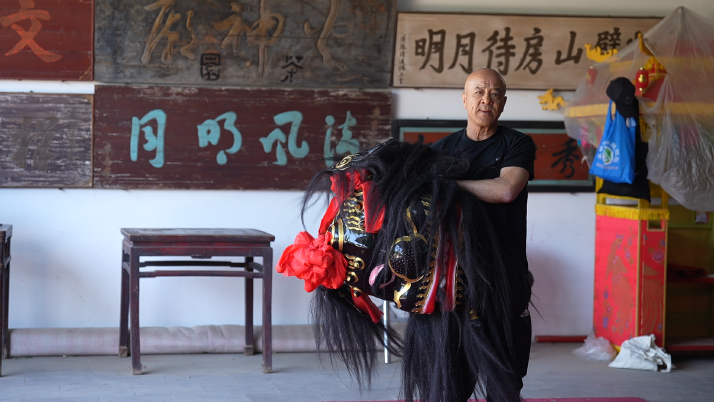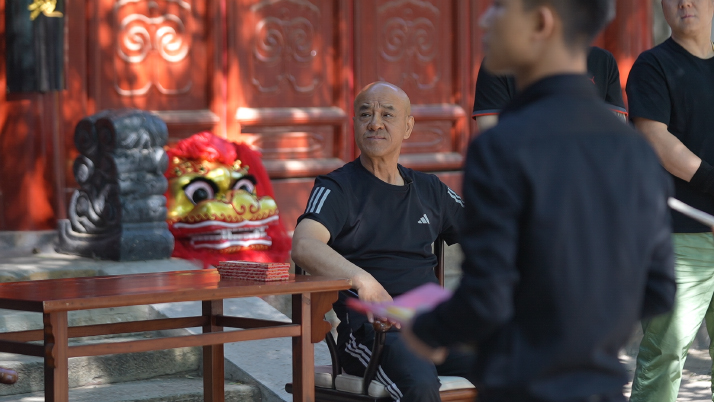| Real People, Real Lives |
| Lion in my heart: Inheritor Yang Jingwei safeguards the soul of Baizhifang Lion Dance | |
|
|
|
|
|
Braving the rising mercury and glaring sunlight in Beijing on May 10, lion dance performers from the capital city's Xicheng District were rehearsing for the upcoming Xicheng District Workers' Games. The opening of the games would feature the Baizhifang Lion Dance, which is recognized as national intangible cultural heritage.
After the first round of rehearsals, the team members removed their heavy lion costumes and sought some shade to cool down. Their master, Yang Jingwei, a seventh-generation inheritor of this specific lion dance, carefully arranged the seven lion heads in a neat row, meticulously combing their manes. "When I joined the team, my master told me that the lion should hold a place of the utmost importance. Arranging the lion heads neatly before stepping onto the stage shows the stature of the lion and the quality of our team," said Yang. Lionhearts Baizhifang is a historical area in Beijing's Xicheng District bearing rich cultural heritage. The eponymous lion dance was born in 1740, the fifth year of Emperor Qianlong's reign during the Qing Dynasty (1644-1911). The performance quickly became the highlight of local festivals, captivating audiences with its eye-catching acrobatic routines. To this day, the Baizhifang Lion Dance stands out among its peers due to its blend of history, culture and physical prowess. It is a living testament to ancient customs and traditions, as well as a real community effort, involving local performers, musicians, and organizers. Yang's passion for the dance was ignited in his childhood. After the founding of the People's Republic of China in 1949, a group of passionate employees from the Beijing Banknote Printing Plant formed a lion dance team. As his father managed the plant's rehearsal hall, Yang got opportunities to spend hours watching the lion dance practices. "From a young age, I knew I loved the lion dance from the bottom of my heart, and that, if given the chance, I would definitely join the team," Yang told Beijing Review. Yang's journey to becoming a lion dance master was anything but straightforward. He first made a name for himself as a weightlifter, then served in the military and later even worked as a police officer. He returned to the Beijing Banknote Printing Plant in 1978. In 1984, as the lion dance team prepared to recruit new members for its performance to mark the 35th anniversary of the People's Republic of China, Yang seized the opportunity to join the lion dance team. Through hard work, he mastered the dance's complex techniques, eventually earning his master's recognition.  Yang Jingwei shows his apprentices some Baizhifang Lion Dance movements at their training ground in Beijing's Shijingshan District on May 16 (Fei Ruicong)
To this day, Yang still remembers what his master once told him: Once the lion costume is on, one must embody the lion itself; true mastery of the Baizhifang Lion Dance is about more than perfecting the movements; it requires capturing the very essence and spirit of the lion. He and his partner demonstrated the true spirit of the lion in 1989, when a Sino-Japanese cultural exchange event brought a folk-art troupe from Shimane Prefecture, Japan to Beijing for lion dance show. A lion dance requires two performers: one for the head and one for the tail. Yang played the tail, responsible for supporting his partner. However, on the day of the performance, there was an accident... Yang and his partner were standing on stacked tables when the latter suddenly lost his balance, causing them both to take a tumble. Yang's leg immediately swelled up, but they adjusted their positions and completed the performance. The following day, despite his injury, Yang still managed to execute every move with precision. "Lion dance performers must learn how to adopt and embody the lion's bravery and persistence," said Yang. Yang and his fellow performers' perseverance moved the Japanese troupe, and they gifted him an amulet, hoping it would bless him in his future performances. A team effort Yang believes that he must live up to his master's expectations by passing on the skills he was taught. As a nationally recognized intangible cultural heritage inheritor, he feels a deep sense of responsibility. "We cannot wait; we must actively take the initiative to protect the heritage," he said. A significant challenge he faces is the gradual fading of this intangible cultural heritage, with fewer people willing to learn it. "When I was young, I was unable to win an opportunity to learn the Baizhifang Lion Dance. Now, it's almost the other way around and I have to ask people to learn it," Yang remarked.  Yang hosts a ceremony to accept new apprentices at Baoguo Temple in Beijing’s Xicheng District on May 12 (Fei Ruicong)
Recalling how his early exposure to the lion dance sparked his curiosity and passion for the art, he said that, to preserve the Baizhifang Lion Dance, it is essential to engage children and pique their interest. "Interest needs to be nurtured. As long as children are curious about the Baizhifang Lion Dance, I am more than willing to provide them with the opportunity to experience it firsthand," Yang said. Currently, Yang leads the lion dance team in promoting the dance to the public, a mission that also takes them to kindergartens, primary schools, middle schools and universities. Another challenge he faces is that the Baizhifang Lion Dance, a northern Chinese-style lion dance, is lesser known than the southern-style counterparts, both in China and overseas. To address this, Yang collaborates with several parties to raise the dance's profile. Besides professional media organizations, university students and social media influencers are often welcomed to film and interview him, and Yang patiently introduces the Baizhifang Lion Dance to everyone. The entire team works together to gradually increase the performing art's visibility. The local government also provides performance opportunities and infrastructure to promote the Baizhifang Lion Dance widely. For instance, the Shijingshan District Cultural Commission in Beijing provided a free training ground, alongside performance opportunities like the Xicheng District Workers' Games on May 11. Yang also broke the tradition of "passing the heritage on to men, not women" by forming a women's lion dance team, who trained diligently to bring the art form to more people. "Currently, from the Baizhifang subdistrict to municipal and central government departments, and media outlets, plus the many people who love to watch lion dances, everyone cares about our Baizhifang Lion Dance. As an inheritor, I must pass this project down through generations, letting more people understand, love and join this lion dance. That is my greatest happiness," said Yang. Copyedited by Elsbeth van Paridon Comments to wangruohan@cicgamericas.com |
|
||||||||||||||||||||||||||||
|